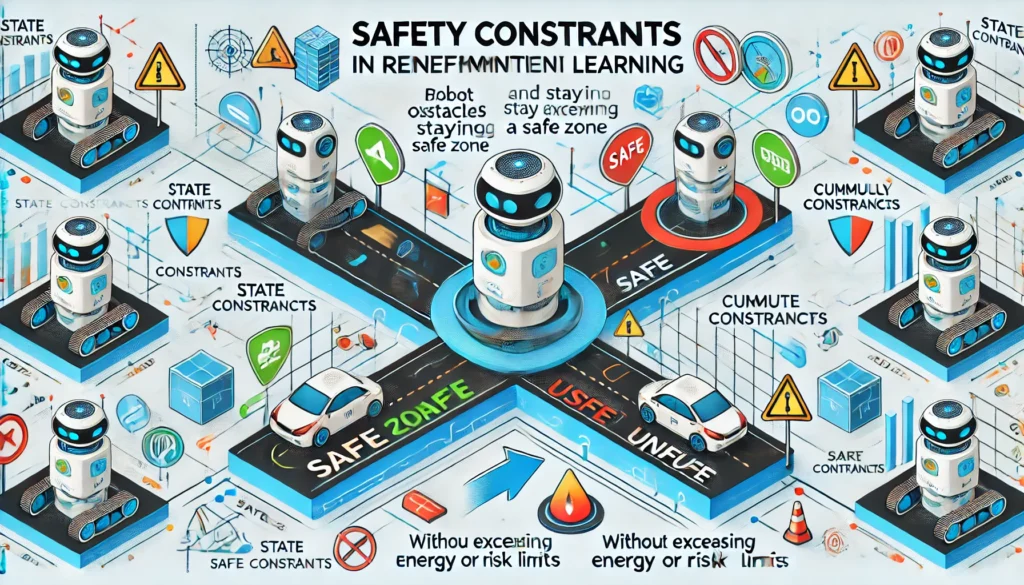Safe reinforcement learning (RL) is a critical area of study that focuses on developing RL methods that not only perform effectively but also adhere to safety constraints to prevent undesirable or dangerous outcomes. This involves integrating various forms of constraints into the learning algorithms to ensure that the policies derived do not violate predefined safety norms. This article provides an overview of how constraints are formulated within the framework of safe RL, discussing the key types, challenges, and methodologies used in the field.
Types of Safety Constraints
- State Constraints: These constraints focus on keeping the RL agent from entering unsafe states. Such formulations are particularly useful in scenarios like robotic navigation in hazardous environments, where certain areas or situations must be avoided to prevent damage or failure.
- Expected Cumulative Safety Constraints: This approach integrates safety as a part of the reward function, akin to adding a regularizer that penalizes unsafe actions. The aim is to optimize the expected cumulative reward while ensuring that the safety measure does not exceed a certain threshold. This is one of the more traditional forms of safety constraint and is akin to modifying the value function to account for safety costs.
- Instantaneous vs. Cumulative Safety Constraints: These constraints differentiate between ensuring safety at each individual timestep (instantaneous) and maintaining safety across the entire duration of an episode or task (cumulative). Each has its application depending on the temporal criticality of the safety requirement.
Challenges in Safe RL
Implementing safety constraints in RL poses several challenges. The primary issue is the trade-off between exploration and exploitation, particularly under stringent safety constraints. Agents must learn about their environment to optimize their policy, but extensive exploration can lead to unsafe actions. Therefore, developing methods that allow safe exploration is crucial.
Another significant challenge is the precise formulation of safety constraints that are computationally feasible and align with real-world safety requirements. Joint chance constraints, for example, involve probabilities of unsafe events and are complex to handle due to their nonlinear and non-convex nature.
Algorithmic Approaches and Solutions
Several algorithmic strategies have been developed to handle these constraints:
- Constrained Policy Optimization (CPO): This method directly incorporates constraints into policy optimization, ensuring that the solutions respect safety criteria while optimizing performance.
- Model-based Approaches: These involve using models of the environment to predict the outcome of actions in terms of safety, thus allowing the agent to avoid unsafe actions proactively.
- Safety Layer Methods: These add a safety ‘filter’ to the RL agent’s actions, ensuring that only safe actions are executed based on a model predicting the safety of given states and actions.
Future Directions
The field of safe RL is rapidly evolving, with ongoing research focusing on more robust formulations that can handle dynamic environments and higher-dimensional state spaces. There is also an increasing interest in applying safe RL to more complex and safety-critical applications like autonomous driving and healthcare, where the cost of failure can be extraordinarily high.
Furthermore, integrating advanced machine learning techniques such as deep learning into safe RL frameworks to handle complex and high-dimensional data more effectively is another promising direction.
Conclusion
A survey of constraint formulations in safe RL highlights the importance of integrating safety into the learning process, ensuring that RL algorithms perform reliably and safely in real-world scenarios. As this field matures, the development of more sophisticated safety mechanisms and their integration into standard RL frameworks will be crucial for the broader adoption of RL technologies in safety-critical applications. This survey serves as a foundational guide for researchers and practitioners interested in the intersection of safety and machine learning.
What is safe reinforcement learning?
Safe reinforcement learning is an area of machine learning that focuses on developing algorithms that not only achieve high performance but also adhere to predefined safety standards to avoid harmful outcomes.
Why are constraints important in safe reinforcement learning?
Constraints are crucial in safe RL because they ensure that the learning process does not lead to unsafe actions. By integrating safety constraints, developers can prevent RL agents from making decisions that could lead to undesirable or dangerous results.
What are some common types of safety constraints in RL?
Common safety constraints include state constraints, which prevent the agent from visiting unsafe states, and cumulative safety constraints, which integrate safety as part of the overall optimization process to ensure that the cumulative safety metric remains within acceptable limits.
How do instantaneous and cumulative safety constraints differ?
Instantaneous safety constraints ensure safety at every individual timestep, making them suitable for highly dynamic environments. Cumulative safety constraints, on the other hand, focus on maintaining safety across the entire episode or duration of the task, which is critical in scenarios where long-term outcomes are important.
What are some challenges in implementing safe RL?
Challenges include balancing the trade-off between exploration and safety, where the agent needs to learn about the environment without taking risky actions. Additionally, formulating computationally feasible safety constraints that accurately reflect real-world requirements is complex.
What future directions exist for research in safe RL?
Future research may focus on more sophisticated safety mechanisms, integrating safe RL in more complex domains like autonomous driving and healthcare, and applying advanced deep learning techniques to manage high-dimensional data effectively.


